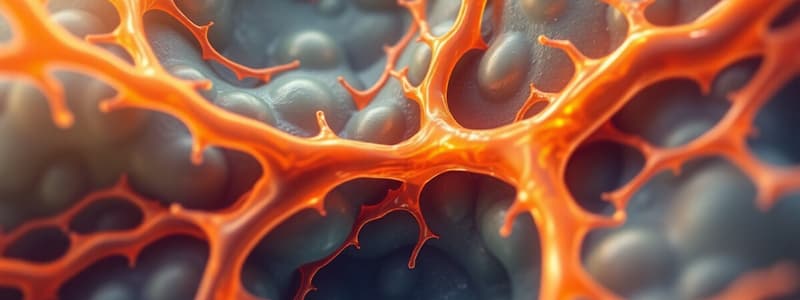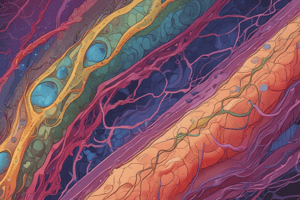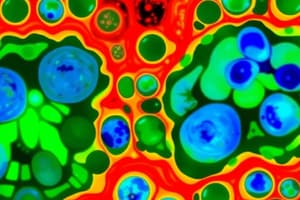Podcast
Questions and Answers
What is the primary role of tissues within the body?
What is the primary role of tissues within the body?
- To carry out specific functions collectively. (correct)
- To prevent cell interaction.
- To act independently of other cells.
- To allow cells to move freely.
Which of the following is true regarding cell junctions?
Which of the following is true regarding cell junctions?
- They facilitate contact between neighboring cells. (correct)
- They are only present in extracellular matrix.
- They consist of single proteins.
- They prevent cell adhesion.
Which of the following is a function of cell junctions?
Which of the following is a function of cell junctions?
- Bonding cells together (correct)
- Preventing communication between neighboring cells
- Causing stress on cells
- Allowing paracellular transport to occur uncontrollably
Where are tight junctions typically located in epithelial cells?
Where are tight junctions typically located in epithelial cells?
What is the primary function of the macromolecules in the interstitial matrix of connective tissue?
What is the primary function of the macromolecules in the interstitial matrix of connective tissue?
Which type of cell junction is associated with anchoring cells to the basal lamina?
Which type of cell junction is associated with anchoring cells to the basal lamina?
What is the main component of tight junctions that seals the gap between epithelial cells?
What is the main component of tight junctions that seals the gap between epithelial cells?
Which tissues are Adherens junctions commonly found in?
Which tissues are Adherens junctions commonly found in?
What type of cell junction enables action potentials to spread rapidly between cells?
What type of cell junction enables action potentials to spread rapidly between cells?
Which type of cell junction contributes to building up the paracellular barrier of epithelia?
Which type of cell junction contributes to building up the paracellular barrier of epithelia?
What is a key characteristic of cell-cell anchoring junctions, such as adherens junctions and desmosomes?
What is a key characteristic of cell-cell anchoring junctions, such as adherens junctions and desmosomes?
Which component is directly linked to intermediate filaments in desmosomes?
Which component is directly linked to intermediate filaments in desmosomes?
What is a primary function of adherens junctions in multicellular structures?
What is a primary function of adherens junctions in multicellular structures?
Which cell junction allows the passage of small hydrophilic molecules between cells without crossing the plasma membrane?
Which cell junction allows the passage of small hydrophilic molecules between cells without crossing the plasma membrane?
What is the main function of desmosomes?
What is the main function of desmosomes?
What is the role of integrins in cell-matrix junctions?
What is the role of integrins in cell-matrix junctions?
Which tissues are hemidesmosomes commonly found in?
Which tissues are hemidesmosomes commonly found in?
What is the role of calcium in cadherin-mediated cell adhesion?
What is the role of calcium in cadherin-mediated cell adhesion?
What is the relationship between cell junctions and tissue formation?
What is the relationship between cell junctions and tissue formation?
Which cell junction is capable of connecting actin filaments in one cell directly to those in an adjacent cell?
Which cell junction is capable of connecting actin filaments in one cell directly to those in an adjacent cell?
Integrins are essential transmembrane receptors involved in cell-matrix anchoring junctions. What cellular process is NOT directly influenced by integrin signaling?
Integrins are essential transmembrane receptors involved in cell-matrix anchoring junctions. What cellular process is NOT directly influenced by integrin signaling?
How do tight junctions contribute to the barrier function in the intestinal epithelium, and what consequences arise from their disruption?
How do tight junctions contribute to the barrier function in the intestinal epithelium, and what consequences arise from their disruption?
What structural feature differentiates desmosomes from adherens junctions?
What structural feature differentiates desmosomes from adherens junctions?
Which statement best compares the structural and functional differences between cell-cell and cell-matrix junctions?
Which statement best compares the structural and functional differences between cell-cell and cell-matrix junctions?
A researcher is studying the pathogenesis of a new autoimmune disease that affects the skin. Microscopic analysis of skin biopsies reveals a significant reduction in the number and integrity of desmosomes in the affected areas. Based on this finding, which of the following is the most likely mechanism contributing to the skin abnormalities observed in this disease?
A researcher is studying the pathogenesis of a new autoimmune disease that affects the skin. Microscopic analysis of skin biopsies reveals a significant reduction in the number and integrity of desmosomes in the affected areas. Based on this finding, which of the following is the most likely mechanism contributing to the skin abnormalities observed in this disease?
Where is the junctional complex located inside polarized epithelium?
Where is the junctional complex located inside polarized epithelium?
What do tight junctions seal?
What do tight junctions seal?
True or False: Tight junctions are absolute diffusion barriers.
True or False: Tight junctions are absolute diffusion barriers.
What are the two types of functionally different forms of anchoring junctions?
What are the two types of functionally different forms of anchoring junctions?
Anchoring functions depend on _____________ adhesion proteins.
Anchoring functions depend on _____________ adhesion proteins.
Cadherins depend on ___________ for rigidty.
Cadherins depend on ___________ for rigidty.
What is another name for Adherens Junctions?
What is another name for Adherens Junctions?
Compared to tight junctions, adherens junctions are located more ____________ .
Compared to tight junctions, adherens junctions are located more ____________ .
What is another name for Desmosomes?
What is another name for Desmosomes?
What do desmosomes connect to in the next cell?
What do desmosomes connect to in the next cell?
What is the gap of gap junctions measured at?
What is the gap of gap junctions measured at?
What is the role of integrins in hemidesmosomes?
What is the role of integrins in hemidesmosomes?
Actin-linked cell-matrix junctions are also known as _________.
Actin-linked cell-matrix junctions are also known as _________.
If calcium is removed, what happens to cadherins?
If calcium is removed, what happens to cadherins?
Which of these structures are NOT involved in mechanical stability?
Which of these structures are NOT involved in mechanical stability?
Flashcards
What is a tissue?
What is a tissue?
Assembly of similar cells and their extracellular matrix, working together for specific functions.
What are cell junctions?
What are cell junctions?
Multiprotein complexes providing contact between neighboring cells or a cell and the extracellular matrix.
What are the functions of cell junctions?
What are the functions of cell junctions?
Bond cells, reduce stress, build paracellular barrier in epithelia, control transport, enable communication, and promote adhesion.
What is the junctional complex?
What is the junctional complex?
Signup and view all the flashcards
What do tight junctions do?
What do tight junctions do?
Signup and view all the flashcards
What proteins form tight junctions?
What proteins form tight junctions?
Signup and view all the flashcards
What are the two forms of anchoring junctions?
What are the two forms of anchoring junctions?
Signup and view all the flashcards
What are anchoring junctions?
What are anchoring junctions?
Signup and view all the flashcards
What do adherens junctions do?
What do adherens junctions do?
Signup and view all the flashcards
What do desmosomes connect?
What do desmosomes connect?
Signup and view all the flashcards
What do gap junctions allow?
What do gap junctions allow?
Signup and view all the flashcards
What do cell-matrix anchoring junctions depend on?
What do cell-matrix anchoring junctions depend on?
Signup and view all the flashcards
What do actin-linked cell-matrix junctions do?
What do actin-linked cell-matrix junctions do?
Signup and view all the flashcards
What do hemidesmosomes do?
What do hemidesmosomes do?
Signup and view all the flashcards
Study Notes
- Cell junctions allow cells to contact neighboring cells, and the extracellular matrix
- Cell junctions consist of multiprotein complexes
Cell Junction Function
- Cell junctions bond cells together
- Cell junctions reduce stress placed upon cells
- Cell junctions build up the paracellular barrier of epithelia
- Cell junctions control paracellular transport
- Cell junctions enable communication between neighboring cells
- Cell junctions adhere cells to the extracellular matrix
Tissues
- A tissue is an assembly of similar cells from the same origin, working together, carrying out specific functions
- Some cell types, such as blood and immune system cells, move freely in the body
- Other cells are packed into tight communities
- Organs are formed by the functional grouping of multiple types of tissues
Epithelial Tissue
- Epithelial tissue covers body surfaces, lines body cavities, and hollow organs
- Epithelial tissue functions include protection, secretion, absorption, excretion, filtration, diffusion, and sensory reception
- Cells are tightly bound together into sheets called epithelia
- Cell-cell junctions attach cells to each other
- Cell-matrix junctions anchor cells onto the basal lamina
Connective Tissue
- In connective tissues, the extracellular matrix (ECM) consists of macromolecules produced by cells, primarily fibroblasts, that are sparsely distributed in the interstitial matrix
- The macromolecules in the interstitial matrix, rather than the cells (fibroblasts) themselves, primarily bear mechanical stress
- Direct attachments between cells are rare
- Epithelial tissue cells attach to the connective tissue through cell-matrix junctions in the ECM
Types of Cell Junctions
- There are two main types of cell junctions: cell-cell junctions and cell-matrix junctions
Types of Cell-Cell Junctions:
- Tight junctions
- Cell-cell anchoring junctions
- Adherens junctions
- Desmosomes
- Gap junctions (communicating junctions/channel-forming junctions)
Types of Cell-Matrix Junctions:
- Cell-matrix anchoring junctions
- Actin-linked cell-matrix junctions
- Hemidesmosomes
Junctional Complex
- The junctional complex is located at the apex of the lateral membrane of polarized epithelial cells
- Involves:
- Regulating cell-cell adhesion
- Paracellular permeability
- Cell polarity
Cell-Cell Junctions
Tight Junctions
- Tight junctions (zonula occludens or occluding junctions) seal the gap between epithelial cells
- They seal the intercellular space from the luminal environment
- The seal is not absolute and acts as a diffusion barrier
- Tight junctions are impermeable to macromolecules, but permeability varies for ions and small molecules
- They serve as selective permeability barriers for paracellular transport
- Usually located at the apical location and found in epithelial cells, such as lining the intestinal mucosa, urinary bladder, and respiratory tract
- Claudin and occludin are the proteins that make up tight junctions
- Tight junction disruption in the intestine causes a leaky gut, associated with the pathogenesis and progression of gastrointestinal diseases
Cell-Cell Anchoring Junctions
- Cell-cell anchoring junctions (adherens junctions and desmosomes) hold cells together
- The lipid bilayer is flimsy, and it cannot transmit large forces from cell to cell by itself
- Functionally different forms:
- Adherens junctions
- Desmosomes
- These junctions hold cells together and are formed by transmembrane adhesion proteins in the cadherin family (calcium-dependent adhesive proteins)
- Anchoring junctions are strong, membrane-spanning structures, tethered inside the cell to the tension-bearing filaments of the cytoskeleton
- They are widely distributed in animal tissues and are abundant in tissues subjected to severe mechanical stress, such as the heart, skeletal muscle, and epidermis
- Cell-cell anchoring junctions depend on transmembrane adhesion proteins
Cadherins
- Calcium-dependent adhesion
- Cadherins depend on extracellular Ca2+ to rigidify the extracellular domains and enable trans junctional homophilic interactions
- Removal of calcium abolishes adhesive activity and renders cadherins vulnerable to proteases
- Cadherins span the plasma membrane, one end linking to the cytoskeleton, and the other end linking to structures outside the cell
Adherens Junctions
- Adherens junctions (zonula adherens, intermediate junction, "belt desmosome" or adhesion belt) connect one actin filament bundle in one cell with that in the next cell
- Cell Junctions provide an anchorage site for the cytoskeleton
- They help to model shape of multicellular structures
- Guide the organization of developing tissues, and help construct vertebrate nervous system
- Located more basal than tight junctions, and Found in most epithelial and endothelial tissues
Desmosomes
- Desmosomes (macula adherens) connect intermediate filaments in one cell to intermediate filaments from the adjacent cell
- Provide anchorage site for cytoskeleton
- Structurally similar to adherens junctions but contain specialized proteins (desmogleins) that link with intermediate filaments instead of actin
- Provide mechanical strength
- Located in tissues that suffer from a lot of stress or stretch, such as skin muscles, intestines, stomach, and urinary bladder
Gap Junctions
- Gap junctions allow the passage of small hydrophilic molecules from cell to cell without passing through the plasma membrane
- Examples of passing molecules through gap junctions are: ions, glucose and second messengers
- The gap between cells is narrow (2-4 nm)
- Important in tissues containing electrically excitable cells
- Action potentials can spread rapidly
- Examples of gap junction usage: cardiac contraction and peristaltic movements of intestines
- Located in epithelial tissues, cardiac muscles, and smooth muscles
Cell-Matrix Junctions
- Cell-matrix anchoring junctions connects the cell to the extracellular matrix
- They depend on integrins (transmembrane proteins) bridging cell-matrix interactions
- Cell-matrix anchoring junctions sense and respond to mechanical forces acting across the junction
Integrins
- Integrins activate after binding intracellular activator proteins and produce intracellular signals that can influence almost any aspects of cell behavior
- embryonic development
- signaling
- proliferation
- survival
- migration
- blood clotting
Actin-Linked Cell Matrix Junctions
- Actin-linked cell-matrix junctions (focal adhesion) anchor actin filaments in cells to the extracellular matrix
- Actin-linked cell matrix junctions can be small, transient, large, and durable
Hemidesmosomes
- Hemidesmosomes anchor intermediate filaments in a cell, to the cell's extracellular matrix
- They are similar in form to desmosomes
- Hemidesmosomes use integrins instead of desmogleins to facilitate a stable adhesion of the basal side of the epithelial cells to the basement membrane (ECM)
Studying That Suits You
Use AI to generate personalized quizzes and flashcards to suit your learning preferences.




